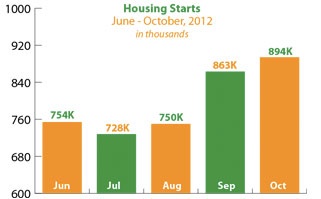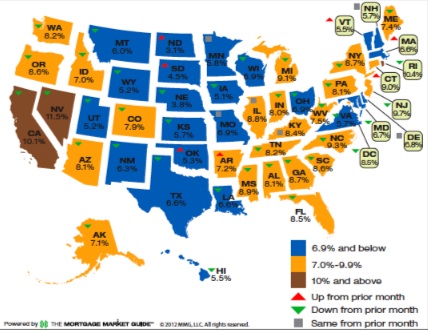|
|
 One of
the bright spots of last month was the housing market. Despite weak numbers
for New Home Sales, Pending Home Sales came in better than expected for the
month of October. Housing Starts were also reported at the highest rate since
July 2008. Finally, home prices in the Case-Shiller Home Price Index
increased 3% over the past year. Those numbers are encouraging because they
present a positive outlook for housing in the near future. One of
the bright spots of last month was the housing market. Despite weak numbers
for New Home Sales, Pending Home Sales came in better than expected for the
month of October. Housing Starts were also reported at the highest rate since
July 2008. Finally, home prices in the Case-Shiller Home Price Index
increased 3% over the past year. Those numbers are encouraging because they
present a positive outlook for housing in the near future.
Despite that good news, the main focus in the markets is the uncertainty of
the looming Fiscal Cliff.
If you've been wondering what the Fiscal Cliff is about, here are the main
issues.
As we head into 2013, tax cuts for individuals and various tax breaks for
businesses are due to expire, taxes pertaining to President Obama's health
care law will begin, spending cuts enacted by Congress as part of the debt
ceiling deal of 2011 will go into effect, and long-term jobless benefits will
expire.
The Congressional Budget Office (CBO) estimates that if all of these items
occur, it could take an estimated $600 billion out of the U.S. economy in
2013, pushing the country into a recession. Given that Europe is officially
in a recession for the second time in four years, it's especially important
that our leaders take action now before our economy follows suit.
Inflation issue?
Heading into 2013, another important issue to monitor is inflation. Remember
that one of the goals of the Fed's latest round of Bond buying (known as
Quantitative Easing or QE3) is actually to create inflation. While the latest
Producer Price Index and Consumer Price Index reports show that inflation
remains tame at the wholesale and consumer levels, inflation can manifest and
get out of hand quickly. This is significant because inflation is the
archenemy of Bonds (that means they're also the enemy of home loan rates,
which are tied to Mortgage Bonds) because it reduces the value of fixed
investments like Bonds.
What does this mean for home loan rates?
Bonds and home loan rates should continue to benefit from the continued
uncertainty in Europe, and the uncertainty here regarding the Fiscal Cliff,
as investors will likely continue to see our Bond market as a safe haven for
their money. But inflation is a very real threat to home loan rates, and we
need to keep a close eye on it in the weeks and months ahead.
The bottom line is that now is a great time to consider a home purchase
or refinance, as home loan rates remain near historic lows. Let me know if I
can answer any questions at all for you.
|
|
 The
U.S. Postal Service recently announced some changes that will take effect in
2013.
The
U.S. Postal Service recently announced some changes that will take effect in
2013. Computer
issues are something that most everyone has experienced-and they are
certainly a big factor that can impact (and sometimes even halt) productivity
during the day. Often, one of the biggest culprits for a slow or
malfunctioning computer is malware.
Computer
issues are something that most everyone has experienced-and they are
certainly a big factor that can impact (and sometimes even halt) productivity
during the day. Often, one of the biggest culprits for a slow or
malfunctioning computer is malware.


No comments:
Post a Comment